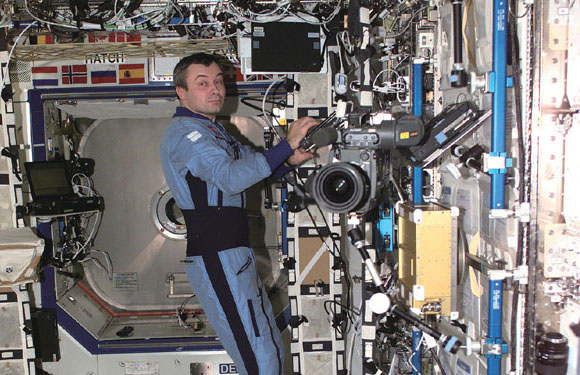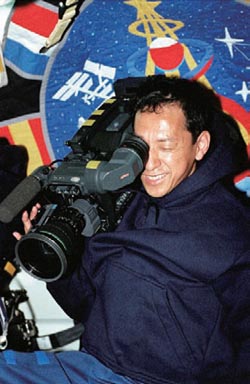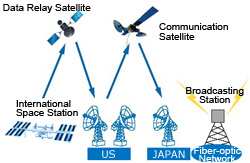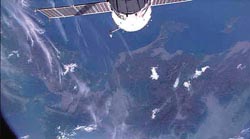This is an archive of information released in the past.
Disclaimer: It may contain broken links or outdated information. Some parts may not function in current web browsers.
*Visit https://humans-in-space.jaxa.jp/en/ for the latest information.

Experiment
- News
- Kibo Utilization Strategy
- Kibo Utilization Plan
- List of JAXA's Utilization Themes
- Experiment Facilities
- Space Environment Utilization
- Archive
Broadcasting from Space with High-Definition Images

An astronaut taking a video with a high-definition television camera
To a World with More Vivid Images
Television cameras aboard the International Space Station (ISS) and the Space Shuttles formerly recorded videos with NTSC signal, which had the same resolution as video recorders for household use. In recent shuttle and ISS missions, however, high-definition television (HDTV) cameras have been used onboard, which allow us to enjoy clear images, such as Earth seen from space, on TV or in TV ads. These images give us the feeling of being up there in space. Most people may remember the TV ad of POCARI SWEAT, a popular Japanese sports drink, featuring an astronaut doing somersaults.
However, until now, with conventional HDTV camera systems, there was no other way than to retrieve recorded video tapes aboard return flights. Therefore, JAXA has developed the HDTV transmitting system with a real-time downlink utilizing commercial technologies.
In addition, JAXA has been examining a phenomenon called “white defects” as part of its research activities on HDTV. White defects are the unevenness of brightness caused by space radiation, which were not really a problem for conventional standard resolution cameras. This means that white defects of HDTV images are a result of extremely high resolution. To understand this phenomenon, irradiation tests for charge-coupled device (CCD) cameras, as well as evaluations of white defects on the CCDs and CMOS sensors aboard the shuttles and the ISS, have been conducted.
Space Experiments Powered by HDTV !

Astronaut Mohri shooting with a high-definition video camera
The greatest merit of using HDTV in space experiments is that high-resolution images can help analyze experimental data in greater detail in various fields. This includes medical experiments, Earth observation, material experiments, and life science experiments. Lower-resolution imaging may fail to properly capture the experimental data, and researchers may overlook accurate information. High-resolution imaging can contribute to obtaining more accurate information.
Such clear images give you the feeling of being right next to the experiments.
Utilizing Constantly Advancing Consumer Products
An astronaut during exercise using a treadmill
Taking a picture of the Hokuriku District with an HDTV camera
Television camera technologies are constantly advancing, and HDTV broadcasting is quickly getting popular. JAXA has conducted safety verification experiments for a wide variety of HDTV cameras from household cameras to broadcasting cameras for future use onboard the ISS.
It is important that JAXA accumulates know-how for verification processes including safety verification, with the aim of actively utilizing state-of-the-art technologies for HDTV systems onboard the ISS.
Broadcasting Studio in Space !
In the future, the HDTV downlink system will be installed in the Japanese Experiment Module (Kibo), where space lectures or space weather forecasts can be broadcasted. HDTV will be actively utilized as a tool for clinical diagnosis and a data collector for space experiments in the near future.
| Copyright 2007 Japan Aerospace Exploration Agency | Site Policy |


